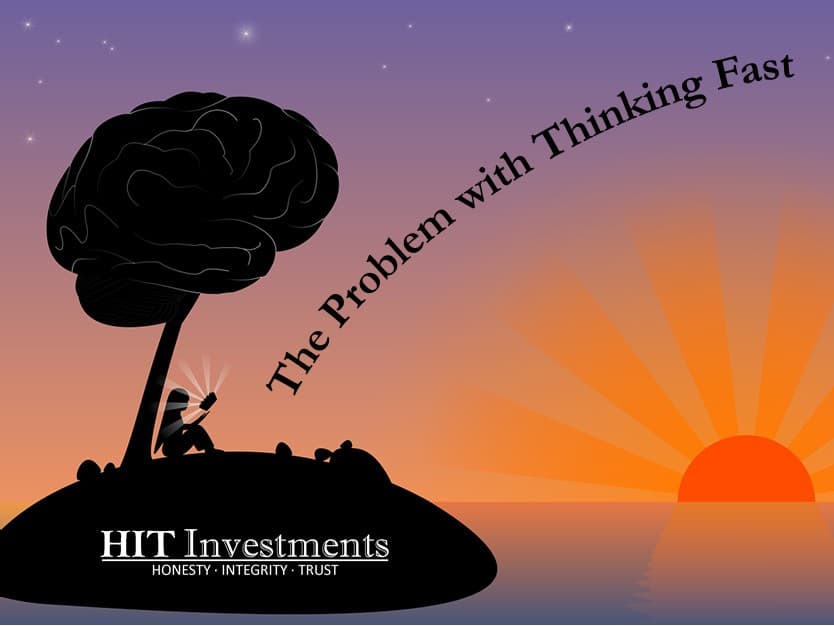A burger and a slice of cheese together cost $1.10. The burger costs a dollar more than the cheese. How much does the cheese cost?
(It’s more impactful if you answer how much the cheese costs before continuing on)
Your answer to the cost of cheese may have depended on which psychological mode of thinking you engaged in. If you chose to answer quickly, your answer was likely 10¢, but if you stopped and worked the answer meticulously then you should have come up with the correct answer of 5¢. For those interested, here’s the algebra:
$1.10 = Cheeseburger Cost
X = Cheese
Y = Burger
X+Y = $1.10
Y-X = $1.00
With two unknowns (X & Y) and two equations we can substitute the first equation into the second.
X+Y=$1.10 → Y=$1.10-X → Substitute $1.10-X for Y
Y-X=$1.00 → ($1.10-X)-X=$1.00 → $1.10-2X=$1.00 → -2x=-$0.10 → x=$.05 → Cheese=$.05
Daniel Kahneman explained these two modes of thought seen in the aforementioned cheeseburger example in his bestseller, Thinking, Fast and Slow. His definition of each was:
- System 1 operates automatically and quickly, with little or no effort and no sense of voluntary control.
- System 2 allocates attention to the effortful mental activities that demand it, including complex computations. The operations of System 2 are often associated with the subjective experience of agency, choice, and concentration.
If you didn’t like the cheeseburger example try to see if you can feel the two modes of thinking when working through the following two equations:
2+2=
15*71=
You automatically knew 2+2 was a math question (System 1) and that the answer was 4 (System 1) but 15*71 required your brain to engage in added mental effort and required a multi-step process to solve the problem (System 2). Each of these modes of thinking has its own abilities, limitations and advantages. Another example of your quick thinking mode is detecting a potentially hostile person just by the tone of their voice or the expression on their face. Checkout the picture of the person below:
You surely recognized that this person was likely angry just as fast as you realized he was a man. This quick mode of thinking historically has helped our ancestors avoid danger. While this reflexive thinking was useful when man lived in caves, it is now often an impediment to successful decision making in 21st century life.
Since the autonomic system 1 kicks in reflexively, we must be aware of its influence when we make personal finance and investment decisions. If given the opportunity, humans naturally want to stay in system 1, where we can quickly and effortlessly make decisions. However, personal finance and investment decisions deserve and demand the detailed thought processes of system 2.
We can see hints of this psychological effect play out in the overall stock market and even more clearly in our personal buy and sell decisions. In fact, HIT Investments studies these behavioral tendencies to gain a competitive advantage. The most common example is the tendency to “buy high and sell low”. When the “consensus” about the market is positive and it trends upwards, the basic instinct is to buy as prices increase. When the “consensus” is negative as the market trends down, the basic instinct is to sell as the price decreases. This is the same system 1 reaction as effortlessly perceiving the man in the picture as angry or simply knowing 2+2 equals 4 without any computation. To keep from falling into this system 1 trap in our personal finance decisions, we must create a set of fundamental rules and reasons why we choose each specific investment. In other words, we must engage system 2 to create an intelligent investment plan. Then when our instincts naturally tell us to sell as the market declines, we have a well thought-out plan to evaluate whether it is a good idea to close or reduce our position. If the original plan remains viable during the downturn, such as having a long-term time horizon where market swings are expected, there is now a logical reason to resist the natural urge to sell.
In the personal finance realm we run into marketers playing to our system 1 thinking on a daily basis. For example:
- a billboard with some delicious looking French fries may make us hungry,
- a sale where the product’s price was originally marked up above the average selling price to start with, i.e. MSRP,
- or how about a solicitor greeting you with a big smile and happy tone when their primary objective is to create a friendly atmosphere to clean out your wallet.
To keep from continuously falling victim to the consumerism culture that surrounds us, we need to be aware of our autonomic system 1 quick thinking mode. We won’t be able to change how our brain works but we can increase our awareness of the process and turn what used to be a liability into an advantage.
Disclosure:
HIT Investments is currently studying how these behavioral biases result in market inefficiencies, specifically in relation to the factor referred to as momentum.




I really like your example as I initially thought it was 10c until I added it up and the result was $1.20 instead of $1.10. Our mind really works in mysterious ways, thanks for the insight.